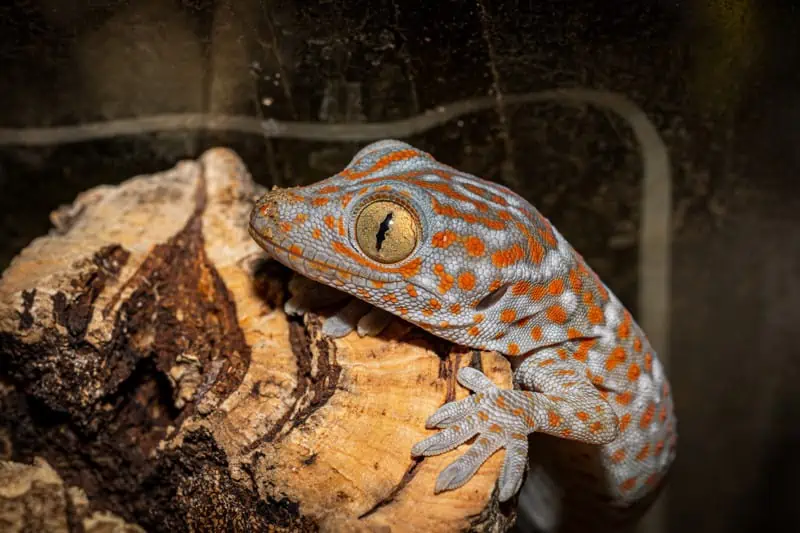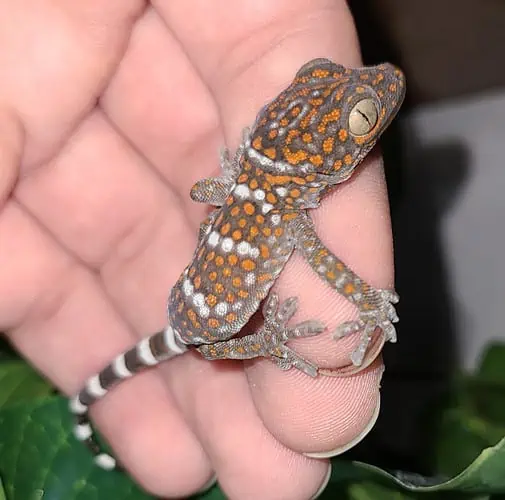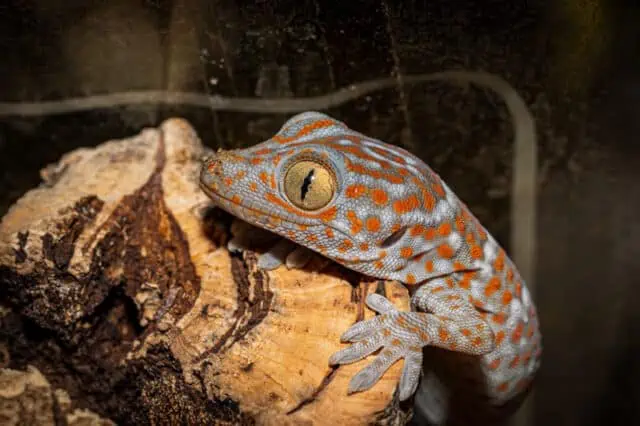Hey there, Gecko enthusiasts! Have you ever watched your vibrant Tokay Gecko and wondered how you could interact with it more? You’re not alone. Many owners are drawn to these fascinating creatures, only to realize they’re not as simple to handle as some other reptile breeds. That’s why we’re here – to guide you on how to handle your Tokay Gecko safely and effectively. So let’s dive right in, shall we?
Understanding the Tokay Gecko: Their Traits and Characteristics
Before we venture into the nitty-gritty of handling, let’s spend a moment appreciating the unique traits and characteristics that make the Tokay Gecko an extraordinary pet. Knowing what makes your gecko tick can drastically improve your interactions with it.
First and foremost, the Tokay Gecko, known scientifically as Gekko gecko, is renowned for its stunning coloration and imposing size. A mature Tokay Gecko can grow up to 15 inches long, making them one of the largest species in the gecko family. Their bodies are beautifully adorned with spots and patterns of bright blue and orange-red, making them a sight to behold.
Another standout characteristic of the Tokay Gecko is its vocal ability. Unlike many other reptile species, Tokay Geckos are quite vocal, known for their distinct mating call that sounds like “To-kay! To-kay!” Hence, they get their name. This also serves as an alarm or warning call when they feel threatened, so it’s good to be aware of this if you’re planning to handle them.
When it comes to behavior, Tokay Geckos are known to be more aggressive and less tolerant of handling compared to other gecko species. They’re nocturnal by nature, meaning they’re most active during the night, and often prefer to be left alone. In the wild, they’re solitary creatures that are territorial and will defend their space aggressively if they perceive a threat.
Tokay Geckos also have a very strong bite, and they’re not afraid to use it. Their teeth are small but sharp, and their jaws are surprisingly powerful. If a Tokay Gecko bites, it can hold on firmly and may not let go immediately. It’s essential to understand this before attempting to handle a Tokay Gecko – their natural instincts make them more defensive, and they won’t hesitate to bite if they feel scared or threatened.
In terms of lifespan, Tokay Geckos can live quite a long time, often 10 to 15 years in captivity if they’re properly cared for. This makes owning a Tokay Gecko a long-term commitment, requiring patience, understanding, and an appreciation for their unique nature.
Knowing these traits and characteristics is a stepping stone to creating a respectful and harmonious bond with your Tokay Gecko. Remember, understanding and respect for their natural behavior are key to successfully handling these unique creatures.
Why Proper Handling is Essential
Proper handling of your Tokay Gecko is more than just a necessity – it’s a responsibility. It’s important to remember that these creatures are not cuddly pets but wild animals with their own unique instincts and behaviors. As such, we need to ensure that our interactions with them are respectful, safe, and beneficial to their well-being.
Handling your gecko correctly can help strengthen your bond and build trust over time. Tokay Geckos are known to be skittish and sometimes aggressive, but with gentle and consistent handling, they can learn to tolerate and even enjoy human interaction.
Moreover, regular handling can also help you monitor your gecko’s health more closely. By handling your gecko, you can check for any physical changes or signs of illness, such as changes in weight, texture of the skin, or unusual lumps. It also allows you to examine your gecko for mites or parasites, which might be otherwise hard to detect.
However, it’s crucial to note that incorrect or stressful handling can do more harm than good. It can result in unnecessary stress for your gecko, lead to injuries, and cause your gecko to become even more defensive or aggressive. It’s also important to remember that not all Tokay Geckos will appreciate being handled, and it’s essential to respect their boundaries and individual personalities.
Preparing to Handle Your Tokay Gecko
Before you reach into the terrarium, let’s run through some essential tips for preparing to handle your Tokay Gecko. After all, preparation is half the battle won.
Set the Mood: Tokay Geckos are nocturnal animals. They’re most active and alert during the night, while they rest during the day. It’s best to handle your gecko during their active hours, preferably in a calm and quiet environment. Sudden noises or movements can startle them and make the handling experience stressful.
Dress Appropriately: Wear appropriate clothing. While it’s true that geckos cannot harm you severely, their bites can be painful. Long sleeves and gloves can provide an extra layer of protection.
Clean Hands: Always wash your hands before and after handling your gecko. This will help prevent the spread of bacteria or harmful substances that could affect your gecko’s health. Use a mild, unscented soap as strong fragrances could be off-putting to your gecko.
Mind the Temperature: Geckos are cold-blooded creatures, which means they rely on their environment to regulate body temperature. Make sure your hands are warm (but not hot) before handling to avoid giving them a temperature shock.
Know Your Escape Routes: Be aware of the surroundings. You wouldn’t want your gecko to escape or to fall from a great height. Make sure all windows and doors are closed, and always handle your gecko close to the ground or over a soft surface.
Have a Plan: Know what to do if your gecko tries to escape, falls, or even bites. Having a plan will help you remain calm and ensure the safety of your gecko during these situations.
With these preparations, you’re all set for a safe and successful handling session. Remember, patience is key – building trust with your Tokay Gecko is a process, not an overnight accomplishment.
Steps to Safely Handle Your Tokay Gecko
Now that you’re prepared, let’s walk through the steps for safely handling your Tokay Gecko. Remember, every gecko is unique, so take your time and let your gecko guide the pace.
Step 1: Gauge Their Mood: Before reaching in, observe your gecko’s body language. If they seem alert, calm, and aren’t showing signs of aggression or fear (like hissing or inflating their body), it’s probably safe to proceed.
Step 2: Approach Slowly: Move your hand slowly towards your gecko, approaching from the side rather than from above. In the wild, predators often swoop down on geckos, so an overhead approach could trigger their defensive instincts.
Step 3: Gentle Contact: Gently touch your gecko’s side or back. Avoid grabbing or restraining them, which could lead to panic or aggression. If your gecko seems comfortable with your touch, proceed to the next step.
Step 4: Lift Correctly: If your gecko is comfortable, slowly and gently slide your hand under their belly and lift them. Support their body evenly, particularly their mid-section and tail, which they use for balance.
Step 5: Transfer Hands: If your gecko is comfortable being lifted, you can practice transferring them from one hand to the other. This gives them a sense of control and helps build their confidence in being handled.
Step 6: Limit the Time: Limit handling sessions to about 10-15 minutes to avoid causing unnecessary stress to your gecko. Remember, quality over quantity matters when it comes to handling sessions.
Step 7: Safe Return: After the handling session, return your gecko gently to their enclosure. Make sure they’re steady before you remove your hand.
Remember, patience is paramount in handling your Tokay Gecko. It’s okay if you don’t get it right the first time, or even the first few times. Consistency and gentle handling will gradually build trust between you and your gecko.
Understanding Their Body Language
Just like us humans, Tokay Geckos communicate a lot through their body language. Being able to read these signals can make handling your gecko much safer and more enjoyable for both of you.
Alert and Curious: An alert gecko will have their eyes open and head raised, often with their tail elevated or slowly waving. They might tilt their head to get a better look at you, which is generally a good sign. It means they’re curious and comfortable.
Fear or Stress: If your gecko is stressed or scared, they might flatten their body against the ground, hiss, or open their mouth in a defensive posture. Their tail might twitch rapidly. In these situations, it’s best to give your gecko some space and try again later.
Anger or Aggression: An angry or threatened Tokay Gecko will puff up their body, open their mouth wide (often accompanied by a hissing or barking sound), and may even lunge or attempt to bite. If you see these signs, do not attempt to handle your gecko. Give them time to calm down.
Content and Relaxed: A relaxed gecko will have a loose, easy posture, with their tail relaxed and their eyes half-closed. If your gecko closes their eyes when you pet them, it’s a sign that they feel comfortable with you.
By understanding these signals, you can tailor your approach to handling your Tokay Gecko, resulting in a more positive experience for both of you. Remember, your gecko’s comfort and safety should always be your top priority.
Common Mistakes
Learning how to handle your Tokay Gecko is a process, and mistakes can happen. However, knowing some common mistakes to avoid can make the learning process smoother and safer for both you and your gecko.
Mistake 1: Rushing the Process: Patience is key when handling Tokay Geckos. They’re naturally defensive creatures, and it can take time for them to grow comfortable with handling. Trying to rush this process can lead to stress, fear, and aggression.
Mistake 2: Ignoring Signs of Stress or Fear: Paying attention to your gecko’s body language is crucial. If they’re showing signs of stress, fear, or aggression, it’s essential to back off and give them some space.
Mistake 3: Grabbing or Restraining Your Gecko: Unlike some pets, geckos don’t appreciate being grabbed or held tightly. Always handle your gecko gently, offering your hand as a platform rather than grabbing them.
Mistake 4: Not Supporting Their Tail: The tail is an essential part of a gecko’s body for balance and mobility. When handling your gecko, always ensure their tail is supported.
Mistake 5: Handling During the Day: Remember, Tokay Geckos are nocturnal. They’re most active and alert during the night, and handling during the day can disrupt their sleep and cause unnecessary stress.
Avoiding these common mistakes can drastically improve your handling experiences and help foster trust between you and your Tokay Gecko. And always remember: every gecko is unique, so be patient and take the time to learn what works best for your individual pet.
Expert Tips for Tokay Gecko Handling
Now that we’ve covered the basics, let’s dive into some expert tips that can further enhance your gecko handling experience. Remember, these tips come from seasoned reptile enthusiasts and experts, but every Tokay Gecko is unique, and what works for one may not work for another.
Tip 1: Use a Herp Hook: For initial handling sessions or particularly skittish geckos, using a herp hook can be beneficial. It allows you to gently lift the gecko without direct hand contact, reducing the risk of a bite.
Tip 2: Provide a Hiding Spot: Having a familiar object from their enclosure during handling sessions can make your gecko feel more secure. This can be a small piece of bark or a small hide.
Tip 3: Practice Consistency: Try to handle your gecko at the same time each day. Consistency helps your gecko understand that handling is a regular part of their routine and not something to fear.
Tip 4: Use Positive Reinforcement: After each successful handling session, reward your gecko with a treat. This positive reinforcement can help them associate handling with positive experiences.
Tip 5: Work with a Buddy: Especially in the beginning, it can be helpful to handle your gecko with a friend or family member present. They can help in case your gecko gets loose or if you need assistance.
Tip 6: Consider Their Perspective: Always try to empathize with your gecko. Understanding their behavior and reactions from their point of view can make handling more compassionate and effective.
These tips, along with the previous steps and precautions, will set you on the path of successfully handling your Tokay Gecko. Remember, the goal is to build trust and create a safe, positive experience for your gecko. It’s not about mastering the handling as quickly as possible, but about fostering a healthy and respectful relationship with your pet.
Conclusion
Handling a Tokay Gecko isn’t as straightforward as picking up a puppy or a kitten, but that’s part of what makes these creatures so captivating. Their unique behaviors, vibrant colors, and distinct personalities make them fascinating pets. With patience, respect, and consistency, you can build a trusting relationship that enables you to safely handle your gecko.
Remember, it’s all about understanding your gecko’s needs and signals and responding appropriately. Each Tokay Gecko is an individual with its own personality, so take your time to learn and adapt to your gecko’s preferences. And never forget: the health, comfort, and well-being of your gecko should always be the priority.
So, there you have it – a comprehensive guide on handling your Tokay Gecko safely and effectively. With these steps and tips in mind, you’re well on your way to creating a healthy bond with your gecko. Happy handling!
Frequently Asked Questions (FAQs)
How often should I handle my Tokay Gecko?
Every Tokay Gecko is different, but as a general rule, it’s good to aim for short, regular handling sessions – perhaps 10-15 minutes every other day. This helps your gecko get used to being handled without causing too much stress.
What should I do if my Tokay Gecko bites me?
Tokay Geckos can give a painful bite, but it’s usually not serious. Clean the wound thoroughly, apply an antiseptic, and cover with a bandage. If the bite is severe or shows signs of infection, seek medical attention.
My gecko seems scared of me. What can I do?
Patience is key. Start by spending time near their enclosure and speaking softly to them. This helps them get used to your presence. Gradually, you can start to introduce your hand into the enclosure without touching them. Over time, this should help your gecko see you as less of a threat.
Can children handle Tokay Geckos?
Tokay Geckos aren’t usually the best choice for young children. They can be defensive and are known to bite when threatened. Older children who understand how to handle the gecko gently and respectfully might be okay, but always supervise any interactions between children and geckos.
Why does my Tokay Gecko keep dropping its tail?
Tail dropping is a defensive mechanism in geckos. It usually happens when they’re scared or stressed. If your gecko is frequently dropping its tail during handling, it may be a sign that the handling is causing too much stress. Try to identify any possible stressors and make the necessary adjustments.
How can I tell if my gecko trusts me?
Signs that your gecko is comfortable with you can include them willingly climbing onto your hand, closing their eyes when you pet them, and not displaying signs of stress or aggression during handling. Remember, trust-building is a gradual process – so be patient!







